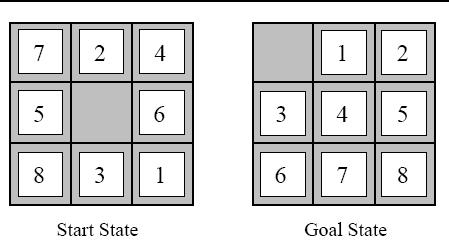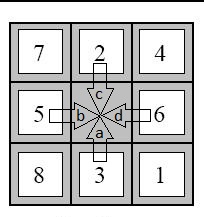
In this assignment you will be implementing the A* search algorithm for solving 3 different search problems - EightPuzzle, WordLadder, and GridSearch. Your single implementation of the algorithm will work for all 3 problems, by properly instantiating an AbstractState class for each of them. You will see both the power of A* as an algorithm that applies to arbitrary discrete state spaces, and the power of heuristics to speed up search.
To get started on this assignment, download the template code. The template contains the following files and directories:
search.py. You will edit and submit this - your
implementation of A* goes here.
state.py. You will edit and submit this - your
implementation of each problem’s State goes here.
utils.py. Some utilities we provide.
maze.py. Some utilities for reading and working with
grid mazes.
main.py. You will run this file to test your
code.
data/eight_puzzle. Text files containing example
problems for the eight puzzle task
data/word_ladder. Text file containing example
problems for the word ladder task, along with a dictionary of english
words
data/mazes. Files containing example mazes to
solve
Please ONLY submit search.py and
state.py.
For each of the remaining parts of the assignment you will find TODOs
in search.py and state.py where you need to
write your own code. For example, for part III you will find TODOs
marked # TODO(III). We’ve provided many comments and
instructions in the code under those TODOs.

There are 2 “TODO(III)” in search.py.
Your first task is to implement a generic best first search algorithm
in the method best_first_search(starting_state) in
search.py. Your implementation should:
Notice that the input to best_first_search is just a
starting state. You may be wondering:
Now you should look at state.py, there are 3 “TODO(III)”
in state.py. These questions should be answered by the
comments in the code under those TODOs. You should first read through
our AbstractState class, then look at an instantiation of
this class called WordLadderState.
In order to test your search code we’ve provided almost all of
WordLadderState. Once you’ve filled in the missing code,
and implemented the search code, you should be able to test your
algorithm. Make sure your algorithm works on all the provided tests
before moving on to the next parts. If it works you will not have to
touch it again!
Run best_first_search on all WordLadder problems:
python3 main.py --problem_type=WordLadder 
Now move on to EightPuzzleState, we’ve provided some but not all of
the code you’ll need here. There are 4 “TODO(IV)” in
state.py.
manhattan(a,b)
EightPuzzleState.get_neighbors(self)
EightPuzzleState.compute_heuristic(self)
EightPuzzleState.__lt__(self, other)Run best_first_search on EightPuzzle problems (all puzzles with puzzle_len=N can be solved in N steps):
python3 main.py --problem_type=EightPuzzle --puzzle_len=5 You can choose any puzzle length among [5, 10, 27].


Finally we come to GridSearch.
Run the following to see mazes and navigate them yourself with the arrow keys:
python3 main.py --problem_type=GridSingle --human --maze_file=[path_to_maze_file in data/mazes/grid_single] --altcolor optionNow you will need to implement the SingleGoalGridState
class. If you would like to see how the maze is built navigate to
maze.py, but otherwise we’ve provided you everything you
need and instructions in state.py where you have 4
“TODO(V)” to complete. The heuristic we use for grid search is the
manhattan distance from the current location to the goal.
You can test your code with:
python3 main.py --problem_type=GridSingle --maze_file=[path_to_maze_file in data/mazes/grid_single] If you would like to also visualize the resulting solution in PyGame
add the --show_maze_vis flag.

We now generalize single goal grid search to multi goal grid search.
There are 5 “TODO(VI)” for you to complete in state.py.
Multiple goals requires a new heuristic. The one we use is the Minimum Spanning Tree (MST). Specifically, given a state and a set of goals, the heuristic cost for visiting all the goals is computed as follows:
We provide you with most of the code you need to compute this MST
heuristic, you can call
compute_mst_cost(self.goal, manhattan) to compute the cost
of the minimum spanning tree for a set of goals. Note that
because computing the mst takes some time, you should store the computed
mst values in the cache we provide you.
You can test your code with:
python3 main.py --problem_type=GridMulti --maze_file=[path_to_maze_file in data/mazes/grid_multi]You can also check backwards compatibility by running GridMulti on a maze file with only one goal.
Submit the main part of this assignment by uploading
search.py and state.py to Gradescope.
You are expected to be familiar with the general policies on the course syllabus (e.g. academic integrity) and on the top-level MP page (e.g. code style). In particular, notice that this is an individual assignment.